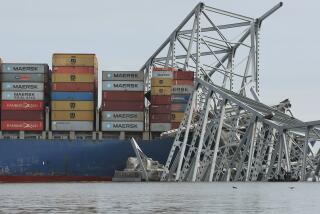Hong Kong’s Bamboo Scaffolding Supports a Risky High-Wire Act
- Share via
HONG KONG — His helmet and safety belt securely in place, 35-year-old Ye Run-jin began his spidery climb up a 61-story apartment building forested with scaffolding of lashed bamboo.
Ye made it to only the third floor that day in June when he missed a step and plunged down an elevator shaft to his death.
Just six days earlier, bamboo scaffolding worker Lam Chi-lung, 22, took a step outside the sixth floor of another building and became a casualty of one of Hong Kong’s deadliest jobs.
In tiny Hong Kong, land fit for development is scarce, so property companies build straight up, filling the horizon with towering high-rises.
When buildings are under construction or under repair, they are shrouded in poles of bamboo scaffolding--which cuts costs and speeds construction. Contractors elsewhere in Asia see it as an outdated hazard.
It is a frequent sight that can startle: workers climbing among rickety-looking poles that creak beneath their weight, up and down through a bamboo grid many stories aboveground, often wearing little or no safety equipment.
“It shows our courage if we do not use a safety belt, and we guys love that,” said Wong Kan-kwun, 45, a bamboo scaffolding worker for 28 years.
Contractors say bamboo as a natural material is unbeatable in terms of flexibility, cost and time, so they use it on 90% of buildings here. Bamboo used in one scaffolding job can be reused, but only once. It is also plentiful in nearby mainland China, where the scaffolding is used only on low-rise projects, structural engineer Poon Sun-wah said.
Many other Asian builders use steel, which is more expensive but safer. Contractors in Japan and Malaysia say they have avoided bamboo for decades because of safety concerns.
“It is too soft to be used as scaffolding--a lot of injuries can happen,” said P. Raguvaran, who runs a construction firm in the Malaysian capital, Kuala Lumpur. “Wooden scaffolding was used up to two years back, but now we use steel because it is much safer, especially for tall buildings.”
In places where some bamboo is still used, such as India, the Philippines and Thailand, the builders don’t go quite so high as in Hong Kong.
Hong Kong workers used bamboo poles--more than 100,000 of them--when they built the territory’s tallest skyscraper, the 78-story Central Plaza office tower, according to Flord So, who oversaw the scaffolding work.
So has been a bamboo scaffolding worker since age 11, but he doesn’t want his son going into the trade.
“It’s too dangerous,” So said.
Critics say safety standards are too often ignored.
Ideally, bamboo used for scaffolding should be 3 to 4 years old. But many farmers sell bamboo when it barely reaches 2 years old and its strength is not fully developed.
“There’s nothing wrong with the material itself, but the government has been too lenient toward employers who fail to care about the safety of their workers,” said Chan Kam-hong, a registered safety officer who works as an advocate for victims of industrial accidents.
The government sees no need to change its rules.
“Bamboo scaffolding is an appropriate and safe construction method if the contractors and employees work in accordance with the government’s codes of practice,” said Labor Department spokeswoman Winnie Siu.
Siu declined comment on safety violations that can be seen all over town. She said officials perform spot checks on construction sites and sometimes prosecute contractors, although no figures are available.
Builders say bamboo costs about 6% of the price of a similar length of steel scaffolding. It can be erected six times faster than steel and requires ordinary laborers, not the heavy machinery needed to put up steel scaffolding, they say. Dismantling it is 12 times faster.
Still, 24 people died here last year from falls, mostly from buildings.
It is unclear how many were scaffolding workers. No such statistics are kept. But the deaths from falling equaled more than half the number of fatalities in construction, where Hong Kong suffers more than 90% of its industrial accidents.
The government insists accidents are declining--by 32% from 1998 to 1999--thanks largely to improved safety awareness. Longer-term figures are not available because officials kept their records differently before 1998.
However, construction activity was slowing then amid a serious recession, which Chan says may partially explain the drop in accidents.
Whatever the number, Chan says people who fall suffer the most serious workplace injuries--skull fractures, loss of arms and legs, all too often death.
Nonetheless, workers say following the safety rules can make their job too awkward and slow, forcing them to miss deadlines.
If a safety belt is tied to the building, workers find it hard to move around. Tying it to the bamboo can pose problems: Sometimes the entire netting falls.
A huge advantage of bamboo is its flexibility, which saves time and money but also leads to some of the pitfalls.
Unlike steel, which must be stacked using standardized framework, bamboo can be cut into different lengths or thatched into various shapes that can be easily changed if workers see fit, said Michael Kan, chief instructor of a construction training center.
Bamboo scaffolding is tied to a building’s facade by 6mm steel bars, or “putlogs,” prefixed to concrete walls. The steel bars are used to stop the scaffolding from falling away from the building.
The integrity and stability of the structure rely on this bracing, said Peter Mok of the Construction Industry Training Authority.
However, scaffolding instructor Choi Keung said most accidents are caused by workers not involved in the scaffolding. They often cut or modify the netting during construction for their own convenience, leaving hidden gaps and fractures that jeopardize the workers climbing outside on the bamboo.
More to Read
Sign up for Essential California
The most important California stories and recommendations in your inbox every morning.
You may occasionally receive promotional content from the Los Angeles Times.













